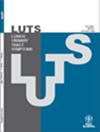To evaluate possible predictors of elevated postvoid residual volume (PVR) following onabotulinumtoxinA administration in patients with idiopathic overactive bladder (OAB), a condition that may include urinary urgency, frequency, and nocturia, without any identifiable cause or underlying neurological or metabolic condition.
Adults who had been treated with 100–200 U onabotulinumtoxinA for OAB and had previous failure of other OAB treatments were identified by retrospective review of medical chart data from three urology clinics in the United States treating patients with a variety of urological conditions. A total of 211 patients were allocated to cohorts based on posttreatment PVR < 200 mL (n = 173) and ≥ 200 mL (n = 38). Logistic regression analyses were performed to evaluate potential predictors of posttreatment PVR ≥ 200 mL, including pretreatment peak urine flow rate (Qmax), average urine flow rate (Qavg), and Modified Liverpool Qmax and Qavg flow index (FI), and to determine whether patient age and baseline PVR were associated with the likelihood of PVR ≥ 200 mL. Patients were excluded if symptoms of OAB were secondary to a neurological condition, they had a PVR > 200 mL within 2 weeks prior to the index therapy or had been treated with other botulinum toxin formulations for a urinary condition.
In the predictor analyses, neither Qmax nor Qavg alone was a likely predictor. Odds ratios of PVR ≥ 200 mL for Modified Liverpool Qmax FI and Qavg were 0.30 (95% CI: 0.08–0.91; p = 0.0488) and 0.07 (95% CI 0.01–0.40; p = 0.0045), respectively. When patient age and baseline PVR were incorporated into the analyses, results suggested that Qmax, Qavg, Qmax FI, and Qavg FI, as well as increased age and baseline PVR, were likely predictors of elevated posttreatment PVR.
Patients who are older, have high pretreatment PVR values, and have lower pretreatment urine flow indexes and flows may be at increased risk of developing elevated PVR after receiving onabotulinumtoxinA treatment for OAB.



